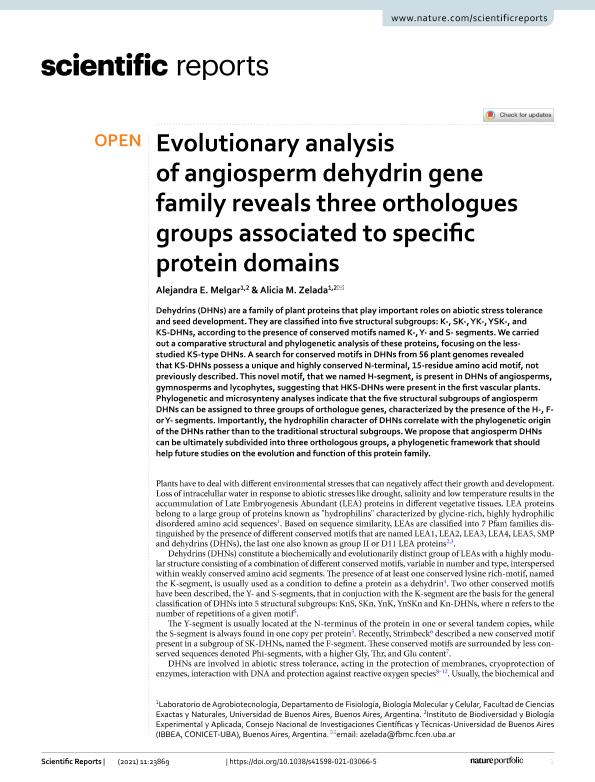Artículo
Evolutionary analysis of angiosperm dehydrin gene family reveals three orthologues groups associated to specific protein domains
Fecha de publicación:
12/2021
Editorial:
Nature
Revista:
Scientific Reports
ISSN:
2045-2322
Idioma:
Inglés
Tipo de recurso:
Artículo publicado
Clasificación temática:
Resumen
Dehydrins (DHNs) are a family of plant proteins that play important roles on abiotic stress tolerance and seed development. They are classified into five structural subgroups: K-, SK-, YK-, YSK-, and KS-DHNs, according to the presence of conserved motifs named K-, Y- and S- segments. We carried out a comparative structural and phylogenetic analysis of these proteins, focusing on the less-studied KS-type DHNs. A search for conserved motifs in DHNs from 56 plant genomes revealed that KS-DHNs possess a unique and highly conserved N-terminal, 15-residue amino acid motif, not previously described. This novel motif, that we named H-segment, is present in DHNs of angiosperms, gymnosperms and lycophytes, suggesting that HKS-DHNs were present in the first vascular plants. Phylogenetic and microsynteny analyses indicate that the five structural subgroups of angiosperm DHNs can be assigned to three groups of orthologue genes, characterized by the presence of the H-, F- or Y- segments. Importantly, the hydrophilin character of DHNs correlate with the phylogenetic origin of the DHNs rather than to the traditional structural subgroups. We propose that angiosperm DHNs can be ultimately subdivided into three orthologous groups, a phylogenetic framework that should help future studies on the evolution and function of this protein family.
Palabras clave:
DEHYDRIN
,
H DOMAIN
,
EVOLUTION
,
PROTEIN DOMAINS
Archivos asociados
Licencia
Identificadores
Colecciones
Articulos(IBBEA)
Articulos de INSTITUTO DE BIODIVERSIDAD Y BIOLOGIA EXPERIMENTAL Y APLICADA
Articulos de INSTITUTO DE BIODIVERSIDAD Y BIOLOGIA EXPERIMENTAL Y APLICADA
Citación
Melgar, Alejandra Estefania; Zelada, Alicia Mercedes; Evolutionary analysis of angiosperm dehydrin gene family reveals three orthologues groups associated to specific protein domains; Nature; Scientific Reports; 11; 1; 12-2021; 1-12
Compartir
Altmétricas




